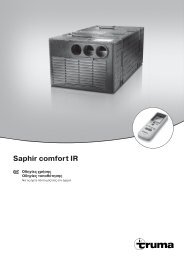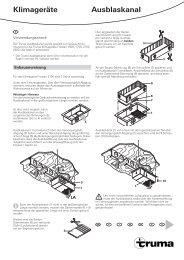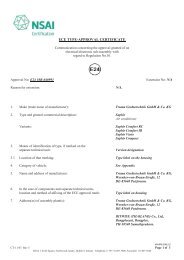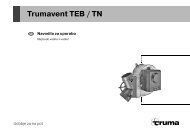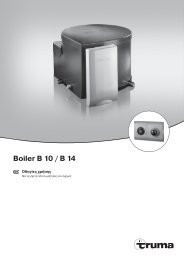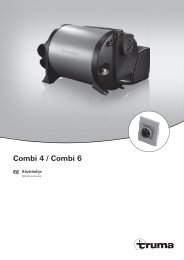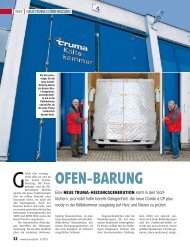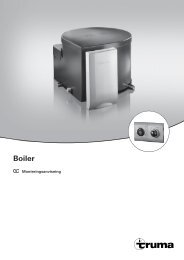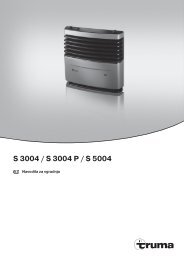Trumove S / T - Truma
Trumove S / T - Truma
Trumove S / T - Truma
Create successful ePaper yourself
Turn your PDF publications into a flip-book with our unique Google optimized e-Paper software.
<strong>Trumove</strong> S / T<br />
Operating instructions Page 2<br />
Installation instructions Page 8<br />
To be kept in the vehicle!<br />
5 YEARS<br />
WARRANTY IS<br />
STANDARD IN<br />
THE UK
<strong>Trumove</strong> S / T<br />
Installation example<br />
1 Remote handset<br />
2 Drive motor<br />
3 Drive roller<br />
4 Electronic control unit<br />
5 Battery<br />
6 Safety socket<br />
Table of contents<br />
Symbols used ......................................................................... 3<br />
Safety instructions ............................................................. 3<br />
General instructions ........................................................... 3<br />
Batteries ................................................................................. 3<br />
Recommended battery capacities ......................................... 3<br />
Charger ................................................................................... 3<br />
Battery care (also maintenance-free batteries) ..................... 3<br />
Function description .......................................................... 4<br />
Operating instructions<br />
Remote handset ..................................................................... 4<br />
Remote hand set LED flash codes and acoustic signal ......... 5<br />
Changing the batteries in the remote handset ...................... 5<br />
Manoeuvring the caravan .................................................. 5<br />
Hitching to a tow car .......................................................... 5<br />
Maintenance ........................................................................ 5<br />
Checks .................................................................................... 6<br />
Emergency disengaging function .......................................... 6<br />
Trouble-shooting ................................................................. 6<br />
Synchronising the electronic control unit with the radio<br />
remote hand set ..................................................................... 6<br />
Technical data ...................................................................... 6<br />
Conformity Declaration ..................................................... 7<br />
Manufacturer’s terms of warranty .................................. 7<br />
Installation instructions<br />
Intended use ........................................................................... 8<br />
Approval ................................................................................. 8<br />
Tools and facilities required ................................................... 8<br />
Minimum installation dimensions .......................................... 8<br />
Measuring the chassis height ................................................ 8<br />
Determining the installation type ........................................... 8<br />
Special accessory installation ................................................ 9<br />
Choice of location .................................................................. 9<br />
Installation of the drive units ............................................ 9<br />
Installation of motor cables and control unit .............. 11<br />
Connecting diagram<br />
(with conventional brake lights) ........................................... 11<br />
Connecting the drive motors ............................................... 11<br />
Connecting the engagement motors ................................... 12<br />
Installing the isolating switch .............................................. 12<br />
Connecting the battery ........................................................ 12<br />
Safety socket connection<br />
with conventional brake lights ............................................. 12<br />
Safety socket connection with LED brake lights ................. 13<br />
Commissioning the <strong>Trumove</strong> S / T ................................. 13<br />
Warning information ............................................................ 13<br />
2
Symbols used<br />
Symbol indicates potential dangers.<br />
Note with information and tips.<br />
Safety instructions<br />
– The <strong>Trumove</strong> S / T control systems may only be used for the<br />
<strong>Trumove</strong> S / T.<br />
– Practice operating the <strong>Trumove</strong> S / T in an open area before<br />
using for the first time. This to fully familiarise yourself<br />
with the handset / mover operation.<br />
– Always check tyres and drive rollers before using the equipment;<br />
remove sharp-edged stones and the like if necessary.<br />
– No person must be present in the caravan during operation.<br />
– All persons (particularly children) must remain outside<br />
the <strong>Trumove</strong> S / T operating area.<br />
– When operating the <strong>Trumove</strong> S / T, ensure that no hairs, fingers<br />
or other body parts, clothing or any other objects carried<br />
on the body can become trapped by moving or rotating<br />
parts (e.g. drive rollers).<br />
General instructions<br />
The <strong>Trumove</strong> S was developed for overcoming inclines of up<br />
to approx. 25 % with a gross weight of 1200 kg and 15 %<br />
with a gross weight of 2000 kg,<br />
and the <strong>Trumove</strong> T for overcoming inclines of up to approx.<br />
25 % with a gross weight of 1200 kg and 10 % with a gross<br />
weight of 2250 kg on a suitable surface.<br />
Depending on the weight of the caravan, the <strong>Trumove</strong> S / T<br />
cannot overcome obstructions that are more than about 3 cm<br />
in height without assistance (please use wedges as a ramp).<br />
Due to the nature of a radio signal, it can get corrupted by external<br />
terrain or objects. So there may be small areas around<br />
the caravan where the quality of reception reduces, hence the<br />
<strong>Trumove</strong> S / T may stop momentarily.<br />
When the <strong>Trumove</strong> S / T is switched off using the remote<br />
control the control unit remains in standby. In order to<br />
switch off completely the battery must be disconnected or<br />
switched off using the isolating switch.<br />
Batteries<br />
We recommend the <strong>Truma</strong> Mover® PowerSet which contains<br />
batteries with round cell technology and a matching charger<br />
to ensure optimum operatoin. So-called drive, lighting and gel<br />
batteries with adequate capacities are also suitable.<br />
– The distance between the radio remote hand set and the<br />
centre of the caravan when manoeuvring must not exceed<br />
10 m!<br />
– In the event of malfunctions pull on the handbrake.<br />
Recommended battery capacities<br />
Round cell technology<br />
min. 55 Ah<br />
– To prevent the caravan from tipping, direct the tow hitch<br />
downhill when manoeuvering down a slope.<br />
– After manoeuvring, always apply the handbrake first,<br />
disengage the drive rollers from the tyres and block<br />
the wheels (particularly on downwards-sloping surfaces).<br />
The <strong>Trumove</strong> S / T is not suitable for use as a parking<br />
brake for a parked caravan.<br />
– Ensure that remote radio control is protected from unauthorised<br />
access (particularly by children!).<br />
– Never tow the caravan with the drive rollers applied. This<br />
can cause damage to the tyres, the towing vehicle and the<br />
drive units.<br />
– All wheels and tyres on the caravan must be of the same<br />
size and design.<br />
– In order to ensure that the <strong>Trumove</strong> S / T operates correctly,<br />
the distance between the tyres and the disengaged drive<br />
rollers must be 20 mm. All tyres must have the same inflation<br />
pressure as per the manufacturer’s instructions (check<br />
at regular intervals!). If tyres are worn or new tyres are fitted,<br />
the distance between the drive rollers and the tyres<br />
may need readjusting (see “Installation of the drive units”).<br />
– Do not use the <strong>Trumove</strong> S / T as a support when jacking up<br />
the caravan, since this can damage the drive unit.<br />
– Sensitive objects such as cameras, DVD-Players etc. must<br />
not be kept in the stowage box near the control unit or the<br />
motor cable. They can be damaged by the electromagnetic<br />
fields.<br />
Gel / AGM<br />
Lead-acid battery (liquid electrolyte)<br />
Starter batteries are not suitable<br />
min. 70 Ah<br />
min. 80 Ah<br />
Batteries with a greater capacity allow longer operation.<br />
Charger<br />
To ensure that the batteries are charged to the optimum, we<br />
recommend the <strong>Truma</strong> charger BC 416 IU that is suitable for<br />
all battery types up to 160 Ah.<br />
Battery care (also maintenance-free batteries)<br />
The following points should be observed to extend the<br />
battery life:<br />
– Batteries should be fully charged before and after they have<br />
been used.<br />
– Disconnect from the power circuit in the case of longer<br />
standstills (e.g. with a circuit-breaker or by disconnecting<br />
the battery terminal).<br />
– In the case of longer standstill periods, the battery must be<br />
disconnected and charged for 24 hours at the latest every<br />
12 weeks.<br />
Store fully charged batteries in a cool but frost-free place<br />
during the winter and recharge regularly (every 12 weeks)<br />
– The empty weight of the vehicle increases by the weight of<br />
the <strong>Trumove</strong> S / T, which reduces the payload of the vehicle.<br />
– Remove plug from safety socket after manoeuvring, otherwise<br />
the battery will be discharged. Standby current with<br />
plug inserted approx. 200 mA. Standby current with plug<br />
removed < 1 mA.<br />
3
Function description<br />
Always observe the operating instructions and “Safety<br />
instructions” prior to starting! The vehicle owner is responsible<br />
for correct operation of the appliance.<br />
Please note that the <strong>Trumove</strong> S is only suitable for<br />
single-axle towed vehicles, and the <strong>Trumove</strong> T is only<br />
suitable for dual-axle towed vehicles.<br />
The <strong>Trumove</strong> S / T is a manoeuvring system with which a caravan<br />
can be moved without the assistance of a towing vehicle.<br />
It consists of two separate drive units, each of which has a<br />
12 Volt DC motor. These units are attached to the frame of the<br />
vehicle near the wheels and are connected by lateral bars.<br />
Once the drive rollers have been engaged to the tyres using<br />
the remote hand set, the <strong>Trumove</strong> S / T is ready for operation.<br />
All operation takes place using the remote hand set. This<br />
transmits radio signals to the control unit. A separate 12 V<br />
lead-acid battery or suitable lead-gel battery (not included in<br />
scope of delivery) supplies the control unit with current.<br />
Operating instructions<br />
Remote handset<br />
a = On / Off slide switch<br />
❙ On (green LED illuminates)<br />
Off (green LED goes off)<br />
b = Caravan forwards (both wheels<br />
rotate in forwards direction)<br />
c = Caravan reverse (both wheels<br />
rotate in reverse direction)<br />
d = Caravan right forwards<br />
(left wheel rotates in forwards<br />
direction)<br />
e = Caravan left forwards<br />
(right wheel rotates in forwards<br />
direction)<br />
f = Caravan right reverse (left wheel<br />
rotates in reverse direction)<br />
g = Caravan left reverse (right wheel<br />
rotates in reverse direction)<br />
<strong>Trumove</strong> S only<br />
The caravan can be turned in a circle on the spot without<br />
moving forward.<br />
d + g = Turn caravan to the right<br />
(left wheel rotates forwards + right wheel rotates<br />
backwards)<br />
e + f = Turn caravan to the left<br />
(left wheel rotates backwards + right wheel rotates<br />
forwards)<br />
<strong>Trumove</strong> T only<br />
Turning on the spot without moving forward is not possible<br />
because of the two axles. Pressing the d, g, e or f buttons<br />
causes the <strong>Trumove</strong> T to move in a circle, whereby the outer<br />
motor runs continuously and the inner motor pulsates.<br />
<strong>Trumove</strong> S / T<br />
h = Two-hand operation, engage drive rollers<br />
i = Two-hand operation, disengage drive rollers<br />
To engage and / or disengage the drive rollers both keys<br />
always need to be pressed at the same time for about<br />
3 seconds (safety lag) until the drive rollers start to engage or<br />
disengage.<br />
The keys can be released again when the drive rollers move<br />
toward the direction of the respective final position. The drive<br />
rollers reach their final position automatically.<br />
Pressing the two buttons for disengaging whilst the<br />
<strong>Trumove</strong> S / T is engaging causes the procedure to be<br />
aborted. The drive rollers will disengage and automatically<br />
move to the end position.<br />
The remote hand set switches off:<br />
– after approx. 2 minutes, if no button is pressed<br />
– after approx. 7 minutes, if one of the movement buttons is<br />
permanently held down. The green LED goes off.<br />
To reactivate the remote control, move slide switch to “Off” <br />
and then back to “On” ❙ after approximately 1 second.<br />
There is no “On / Off” switch on the caravan to be operated.<br />
4
Remote hand set LED flash codes and<br />
acoustic signal<br />
LED “On” and no acoustic signal<br />
System is ready for operation<br />
LED “Off” and no acoustic signal<br />
System off (check remote hand set batteries if necessary)<br />
LED “flashes” in combination with acoustic signal<br />
– for approx. 5 seconds after switching the remote hand set<br />
on, until the system is ready for operation.<br />
– for approx. 10 seconds after switching the remote hand set<br />
on, then it is switched off again – 7-pin or 13-pin safety plug<br />
not connected to safety socket or unable to establish radio<br />
link to controller.<br />
– every 3 seconds if the caravan battery has a low charge (finish<br />
manoeuvring as quickly as possible and charge battery).<br />
– 5 times per second (5 Hz) if the caravan battery voltage is<br />
low. No manoeuvring is possible until the battery voltage<br />
is above 11 V again (e.g. by means of recovery / battery<br />
charging). The drive rollers can also be disengaged with a<br />
voltage of less than 11 V.<br />
– approx. 2 times per second with overcurrent / overtemperature<br />
(2 Hz). Switch remote hand set off and on<br />
again (wait for cooling down if necessary in the event of<br />
overtemperature).<br />
Changing the batteries in the remote handset<br />
Please be sure to use leak proof microbatteries<br />
only, type LR 03, AAA, AM 4,<br />
MN 2400 (1.5 V).<br />
When fitting new batteries<br />
ensure the polarity is correct!<br />
Dead and used batteries may<br />
leak and damage the remote<br />
handset! Remove the batteries if the<br />
handset is not going to be used for an<br />
extended period.<br />
No claims under guarantee will be considered for damage<br />
caused by leaking batteries.<br />
Before throwing away a defective handset, it is essential that<br />
the batteries are removed and disposed of in proper manner.<br />
Manoeuvring the caravan<br />
Please read the “Safety instructions” before using<br />
the <strong>Trumove</strong> S / T!<br />
Apply handbrake with caravan uncoupled.<br />
Unplug 7-pin or 13-pin plug from vehicle and plug into safety<br />
socket of caravan.<br />
For safety reasons the <strong>Trumove</strong> S / T can only be operated<br />
if the 7-pin or 13-pin plug of the caravan has been<br />
plugged into the safety socket.<br />
In the event of an error, the 7-pin or 13-pin plug should<br />
not be removed from the safety socket as otherwise the<br />
electronic protection function is deactivated.<br />
If there is a fault in both caravan brake lights, the power<br />
circuit of the safety socket is not closed. In this case the<br />
<strong>Trumove</strong> S / T cannot be operated.<br />
Switch remote hand set on – green LED flashes for 5 seconds<br />
in combination with the acoustic alarm until the control unit is<br />
ready for operation.<br />
Simultaneously press the two buttons (h) for engaging, which<br />
starts after approx. 3 seconds (safety delay).<br />
Use the position indicator to check whether both drive<br />
rollers have been correctly applied (arrow of yellow position<br />
indicator is above the line that is closest to the tyre).<br />
Before operating the <strong>Trumove</strong> S / T, release the<br />
handbrake.<br />
The six direction buttons provide movement in six directions<br />
– forward, reverse, left forward, left reverse, right forward,<br />
right reverse.<br />
With the <strong>Trumove</strong> S the “left forward” (e) and “right reverse”<br />
(f) or “right forward” (d) and “left reverse” (g) buttons<br />
can also be pressed simultaneously in order to turn the caravan<br />
in a circle on the spot without moving it forwards.<br />
The soft start / stop facility means that the caravan starts<br />
without jerking and is gently braked when stopping.<br />
If the buttons are released or the radio signal is interfered with<br />
or becomes too weak, the caravan stops. Your <strong>Trumove</strong> S / T<br />
cannot be activated by radio devices or other Mover® remote<br />
hand sets.<br />
After starting up, the <strong>Trumove</strong> S / T moves at a uniform speed.<br />
The speed will increase a little when going downhill and decrease<br />
a little when going uphill.<br />
After manoeuvring, first apply the handbrake and then<br />
disengage the drive rollers from the tyres.<br />
Move slide switch on remote control to the “Off” position<br />
to switch the remote control and the <strong>Trumove</strong> S / T off.<br />
The slide switch also acts as an “Emergency stop”<br />
switch.<br />
Remove plug from safety socket after manoeuvring, otherwise<br />
the battery will be discharged. Standby current with plug<br />
inserted approx. 200 mA.<br />
Hitching to a tow car<br />
It is totally possible to position the caravan’s hitch to a stationary<br />
car tow ball using the <strong>Trumove</strong> S / T, but take some care.<br />
Use the instructions above as your guide. Use the button controls<br />
to bring the caravan to the car (car handbrake “ON”, and<br />
car in gear). Use a button stabbing technique to exactly position<br />
the hitch directly over the ball. Lower the hitch to the ball<br />
and engage in the normal way using the jockey wheel.<br />
Prepare the caravan for towing as usual. The caravan must<br />
never be towed with the drive rollers engaged.<br />
Maintenance<br />
Please do not allow the drive units to become soiled with<br />
coarse road material. When you are cleaning the caravan,<br />
spray the <strong>Trumove</strong> S / T with a water hose to dissolve mud<br />
etc. Please ensure that no stones, twigs or the like become<br />
trapped in the equipment. The control unit does not require<br />
maintenance. Please keep the remote hand set in a dry place.<br />
Every year (and / or before putting away for the winter), clean<br />
<strong>Trumove</strong> S / T as described, dry and lightly spray the drive unit<br />
guides with oil spray or a similar water-repelling lubricant. Do<br />
not put lubricant on the rollers or the tyres! Engage and<br />
disengage the drive units several times to allow the lubricant<br />
to penetrate all the guides. Do not park the caravan with the<br />
drive rollers engaged.<br />
5
To prevent the battery from becoming totally discharged during<br />
long periods of inactivity it must be disconnected and<br />
recharged before using again. Charge the caravan battery<br />
before starting up.<br />
It is extremely easy for you or your caravan dealer to perform<br />
the checking and maintenance of your <strong>Trumove</strong> S / T during<br />
the annual inspection of your caravan. If in doubt, please<br />
contact the <strong>Truma</strong> Services (see <strong>Truma</strong> Service Booklet or<br />
www.truma.com).<br />
Checks<br />
– Check the installation, wiring and connections for damage<br />
at regular intervals. The drive units must be able to move<br />
freely and be returned automatically to the safe idle position<br />
when they are disengaged. If this is not the case, examine<br />
drive units for soiling or corrosion at the guides and clean<br />
if necessary. Undo all moving parts as required and oil or<br />
spray with a lubricant such as WD40 to ensure that the<br />
equipment moves correctly and provides the full range of<br />
movement.<br />
– After the annual inspection, check whether all motors react<br />
properly to the buttons on the remote control.<br />
– At least every 2 years, an expert must check the<br />
<strong>Trumove</strong> S / T for rust, check that detachable parts are<br />
firmly attached and check that all safety-related parts are in<br />
good working order.<br />
Emergency disengaging function<br />
If the caravan battery has become so discharged that a disengaging<br />
cannot be performed using electrical means, or a fault<br />
has occurred, the drive motors can be disengaged manually.<br />
Prise out the plastic cap (m) at the<br />
rear end of the motor using a screwdriver.<br />
Place the socket wrench<br />
(size 7 mm – included in scope of<br />
delivery) onto the hexagon bolt and<br />
disengage the drive unit by turning<br />
anticlockwise. Repeat procedure at<br />
the opposite side.<br />
Once the battery has been recharged the rollers can be<br />
engaged again electrically.<br />
Trouble-shooting<br />
Check that the batteries in the remote handset are in immaculate<br />
condition!<br />
Check whether the caravan plug has been plugged into the<br />
safety socket!<br />
Check whether the caravan battery is in immaculate condition<br />
and is fully charged! Please note that battery performance can<br />
deteriorate considerably at cold ambient temperatures.<br />
Check whether the flat fuse (20 A) for the engagement<br />
motors is OK. If the fuse is defective, check the engagement<br />
motor connecting cables at the controller for possible short<br />
circuiting!<br />
Perform a reset (approx. 10 seconds – briefly disconnect<br />
battery, move isolating switch to “OFF” and then back to<br />
“ON”, or disconnect and reconnect safety plug)!<br />
m<br />
Synchronising the electronic control unit with<br />
the radio remote hand set<br />
The remote hand set and the control unit are synchronised<br />
with each other in the factory.<br />
If the control unit or the remote hand set is replaced, they<br />
must be re-synchronised as described below.<br />
Check the installation in accordance with the installation instructions<br />
and ensure that the drive rollers are not applied.<br />
Check that the battery is properly connected, check the condition<br />
of the battery and that a voltage of 12 V is present at the<br />
control unit. Please ensure that the caravan plug has been<br />
plugged into the safety socket.<br />
Press the reset button (k) on the control unit and hold down<br />
(red LED – j – flashes slowly), and after approx. 5 seconds<br />
the LED (j) starts to flash rapidly. Then release the reset button<br />
and press and hold down the caravan reverse button on<br />
the remote hand set (c) within 10 seconds, simultaneously<br />
switching on the remote hand set using the slide switch (a).<br />
j<br />
k<br />
The remote hand set and the control unit are synchronised to<br />
each other. After successful synchronisation, the red LED<br />
flashes rapidly.<br />
Technical data<br />
Operational voltage<br />
12 V DC<br />
Current consumption<br />
average approx. 35 A maximum 150 A<br />
Stand by consumption<br />
< 1 mA<br />
Remote hand set frequency<br />
Class 1, 868 MHz<br />
Speed<br />
approx. 17 cm per second (depending on weight and incline)<br />
Weight<br />
approx. 33 kg<br />
Fuse engagement motors<br />
Blade fuse 20 A<br />
Fuse in positive supply cable<br />
150 A<br />
Area of operation <strong>Trumove</strong> S<br />
Single axle caravans with a total weight up to 2000 kg<br />
Area of operation <strong>Trumove</strong> T<br />
Dual axle caravans with a total weight up to 2250 kg<br />
Right to effect technical modifications reserved!<br />
a<br />
c<br />
If this does not solve the problem, please contact the <strong>Truma</strong><br />
Service.<br />
6
Conformity Declaration<br />
1. Manufacturer master data<br />
Name:<br />
Address:<br />
<strong>Truma</strong> Gerätetechnik GmbH & Co. KG<br />
Wernher-von-Braun-Str. 12, D-85640 Putzbrunn<br />
2. Equipment identification<br />
Model / Version :<br />
<strong>Trumove</strong> S / T manoeuvring aid<br />
3. Complies with the requirements of the following<br />
EC directives<br />
3.1 R&TTE directive (1999/5/EC)<br />
3.2 EMC directive (2004/108/EC)<br />
3.3 Radio Interference in Vehicles 72/245/EEC<br />
(with the supplements)<br />
3.4 Machinery Directive 2006/42/EC<br />
3.5 End of Life Vehicles (2000/53/EC)<br />
and bears the type approval number e1 03 4473 and the CE<br />
symbol.<br />
<strong>Trumove</strong> S / T:<br />
Class 1, frequency 868 MHz.<br />
Countries:<br />
AT, BE, BG, CH, CY, CZ, DE, DK, EE, ES, FI, FR, GB, GR, HU,<br />
IE, IS, IT, LT, LU, LV, MT, NL, NO, PL, PT, RO, SE, SI, SK.<br />
4. Basis of proof of conformity<br />
EN300220-2:2006, EN300220-1:2006 (R&TTE art. 3.2),<br />
EN301489-1:2005, EN301489-3:2002 (EMC art. 3.1b),<br />
EN61000-4-2:2001, EN61000-4-3:2006, EN61000-4-6:2001,<br />
EN55022:2003 (Class B), ISO 7637-2:2004, EN60950:2001,<br />
2004/104/EC, 2005/83/EG, 2006/28/EC, 2006/42/EC, 2000/53/EC<br />
5. Monitoring body<br />
Federal Office for Motor Traffic<br />
6. Information concerning position of undersigned<br />
Manufacturer’s terms of warranty<br />
1. Case of warranty<br />
The manufacturer grants a warranty for malfunctions in the<br />
appliance which are based on material or production faults.<br />
In addition to this, the statutory warranty claims against the<br />
seller remain valid.<br />
A claim under warranty shall not pertain<br />
– for parts subject to wear and in cases of natural wear and<br />
tear,<br />
– as a result of using parts that are not original <strong>Truma</strong> parts in<br />
the units,<br />
– as a consequence of failure to respect <strong>Truma</strong> instructions<br />
for installation and use,<br />
– as a consequence of improper handling,<br />
– as a consequence of improper transport packing.<br />
2. Scope of warranty<br />
The warranty is valid for malfunctions as stated under item 1,<br />
which occur within 60 months after conclusion of the purchase<br />
agreement between the seller and the final consumer.<br />
The manufacturers will make good such defects by subsequent<br />
fulfilment, i.e. at their discretion either by repair or<br />
replacement. In the event of manufacturers providing service<br />
under warranty, the term of the warranty shall not re-commence<br />
a new with regard to the repaired or replaced parts;<br />
rather, the old warranty period shall continue to run. More<br />
extensive claims, in particular claims for compensatory damages<br />
by purchasers or third parties, shall be excluded. This<br />
does not affect the rules of the product liability law.<br />
The manufacturer shall bear the cost of employing the <strong>Truma</strong><br />
customer service for the removal of a malfunction under warranty<br />
– in particular transportation costs, job and material<br />
costs, as long as the service is carried out by an authorised<br />
<strong>Truma</strong> Dealer.<br />
Additional costs based on complicated removal and installation<br />
conditions of the appliance (e.g. removal of furniture or<br />
parts of the vehicle body) do not come under warranty.<br />
Rollers carry 60 months warranty against manufacturing defects.<br />
Take care to remove sharp stones from your tyres prior<br />
to using your Mover®.<br />
3. Raising the case of warranty<br />
Signature: Mathias Venschott<br />
Head of product centre climate and<br />
manoeuvring systems Putzbrunn, 24.09.2012<br />
The distributor‘s address is:<br />
<strong>Truma</strong> UK Limited<br />
2000 Park Lane, Dove Valley Park<br />
Foston<br />
South Derbyshire DE65 5BG.<br />
In Germany, always notify the <strong>Truma</strong> Service Centre if problems<br />
are encountered; in other countries the relevant service<br />
partners should be contacted (see <strong>Truma</strong> Service Booklet or<br />
www.truma.com). Complaints must be specified. Please also<br />
specify the device serial number and date of purchase.<br />
In order to allow the manufacturer to check whether it is a<br />
warranty case, the end consumer must take or send the device<br />
to the manufacturer at his own risk.<br />
In instances of the device being sent to the works, dispatch is<br />
to be effected by freight transport. In cases under warranty,<br />
the works shall bear the transport costs or the costs of delivery<br />
and return. If the damage is deemed not to be a warranty<br />
case, the manufacturer shall notify the customer and shall<br />
specify repair costs which shall not be borne by the manufacturer;<br />
in this case, the customer shall also bear the shipping<br />
costs.<br />
7
Installation instructions<br />
Read the installation instructions prior to starting work and<br />
follow them carefully!<br />
Please ensure that no metal chips or other contaminants get<br />
into the controller during installation.<br />
In the case of screws with sealants, steps must be taken<br />
to ensure that the thread is free of grease / oil.<br />
Intended use<br />
The <strong>Trumove</strong> S is designed for use on single-axle caravans<br />
with a gross weight of up to 2000 kg,<br />
and the <strong>Trumove</strong> T is designed for use on dual-axle caravans<br />
with a gross weight of up to 2250 kg.<br />
The <strong>Trumove</strong> S / T weighs approx. 33 kg.<br />
Check the towing load of your vehicle and the gross weight of<br />
your caravan in order to establish whether they are designed<br />
for the additional weight.<br />
Approval<br />
The <strong>Trumove</strong> S / T satisfies other requirements stated in the<br />
EC directives and standards (see declaration of conformity).<br />
The technical and administrative regulations of the country in<br />
which the vehicle is initially registered must be complied with<br />
when the <strong>Trumove</strong> S / T is being installed.<br />
Minimum installation dimensions<br />
A distinction is made between L-profiled and U-profiled<br />
chassis as shown in the illustration.<br />
L-profile<br />
Caravan floor<br />
U-profile<br />
The equipment can only be fitted to caravans / trailers within<br />
the following dimensions.<br />
max. 20<br />
Caravan floor<br />
170<br />
min. 25<br />
min. 35 **<br />
min.<br />
170*<br />
min. 50<br />
min. 1200 / max. 2000<br />
max. 2400<br />
All dimensions in mm.<br />
* for a loaded vehicle with a max. allowed gross weight<br />
** for U-profile<br />
min. 2.8<br />
Measuring the chassis height<br />
A frame height of min. 170 mm is required about 330 mm<br />
from the outer edge of the tyre at the height of the wheel<br />
hub / centre.<br />
Any modifications to the unit or the use of spare parts and<br />
accessories that are important to the operation of the system<br />
that are not original <strong>Truma</strong> parts and failure to follow the installation<br />
and operating instructions will cancel the warranty<br />
and indemnify <strong>Truma</strong> from any liability claims. In addition to<br />
this, the operational approval for the device will be cancelled.<br />
Tools and facilities required<br />
To install the unit you will need<br />
330<br />
Determining the installation type<br />
min. 170<br />
– 13 mm, 17 mm socket wrench, ring spanner or<br />
open-jawed spanner<br />
– Torque wrench (5 – 50 Nm)<br />
– Cable cutter / Crimping tool<br />
– Power drill / screwdrivers / 25 mm hole cutter<br />
– Portable 2 tonne trolley jack and axle stands to suit<br />
– Appropriate lighting<br />
1. Standard installation<br />
Standard installation for chassis with a U or L-profile and a<br />
frame height of min. 170 mm. No special accessories are<br />
required.<br />
2. Installation in a chassis with a U or L-profile and<br />
frame height between 110 mm and less than 170 mm<br />
The spacer set 30 mm (up to 140 mm frame height) or spacer<br />
set 60 mm (less than 140 mm frame height) is required to<br />
compensate the height difference.<br />
3. Installation with chassis with U-profiles or L-profiles<br />
with frame height of less than 110 mm<br />
A low chassis kit needs to be used to compensate the<br />
height difference for chassis with a height of less than<br />
110 mm.<br />
4. The AL-KO Vario III / AV installation kit must be used<br />
with the AL-KO Vario III / AV chassis with a frame thickness of<br />
less than 2.8 mm.<br />
4a. For mounting in front of the axle on the AL-KO<br />
chassis M, with sliding rails<br />
The AL-KO Chassis M Adapter set needs to be used to<br />
compensate the overlapping frame edges.<br />
5. Installation with Eriba Touring chassis<br />
The Eriba Touring mounting set is needed for the<br />
Eriba Touring chassis.<br />
8
Special accessory installation<br />
1. Spacer set 30 mm<br />
For compensating the height difference<br />
for caravans / trailers with a<br />
frame height of less than 170 mm<br />
and up to 140 mm,<br />
part no. 60030-95000.<br />
2. Spacer set 60 mm<br />
For compensating the height difference<br />
for caravans / trailers with a<br />
frame height of less than 140 mm<br />
and up to 110 mm,<br />
part no. 60030-95100.<br />
The <strong>Trumove</strong> S / T is not approved for installation<br />
on caravans / trailers with any other chassis!<br />
No holes may be drilled into or welding work performed on<br />
the vehicle frame (except when using the low chassis kit* and<br />
the Eriba-Touring mounting set). Under no circumstances remove<br />
any suspension components from the chassis.<br />
* In the case of the AL-KO Vario III / AV Chassis, never drill<br />
into the vehicle frame even if the flat frame kit is used.<br />
Choice of location<br />
The <strong>Trumove</strong> S / T should preferably be installed in front of the<br />
axle, but can also be installed behind the axle under special<br />
circumstances (e.g. lack of space). Only the bolts that are provided<br />
must be used to secure the Mover® (or the add-on parts<br />
provided as special accessories).<br />
Installation of the drive units<br />
3. Low chassis kit<br />
For compensating the height difference<br />
for caravans / trailers with a<br />
frame height of less than 110 mm<br />
and / or for bridging struts,<br />
part no. 60010-64900.<br />
The frame of the vehicle must be kept free of rust and heavy<br />
soiling and without any damages to the suspension<br />
components.<br />
The wheels and tyres that are fitted to the caravan must be<br />
of the same size and model and inflated as per the manufacturer’s<br />
instructions.<br />
Remove all components from packing and place on the floor.<br />
3a. Low chassis kit, short<br />
For compensating the height difference<br />
for caravans / trailers with a<br />
frame height of less than 110 mm,<br />
part no. 60030-37600.<br />
4. AL-KO Vario III / AV<br />
Installation kit<br />
For caravans with<br />
AL-KO Vario III / AV Chassis<br />
(frame thickness less<br />
than 2,8 mm) mandatory,<br />
part no. 60010-21500.<br />
The provided factory plates (f) must be attached on the<br />
left and right sides of the cross strut between the drive<br />
unit retaining plates.<br />
4a. AL-KO Chassis M Adapter set<br />
Mounting set to compensate the<br />
frame edges for caravans with<br />
AL-KO Chassis M,<br />
part no. 60030-38600.<br />
5. Mover® mounting set<br />
for Eriba-Touring,<br />
part no. 60030-09000.<br />
Loosely attach the drive units to the lateral bar. The bolts<br />
(lock nuts) must be no more than finger-tight.<br />
Nut M8 (4 x) M8 x 30 (4 x)<br />
f<br />
Installation is not possible in<br />
some cases because of<br />
attachments to the underbody.<br />
Contact your dealer if necessary.<br />
60 - 100 mm<br />
Detailed installation instructions are provided with the<br />
relevant mounting set.<br />
9
Place the drive units with the crossbar and attachment set (b)<br />
onto the vehicle frame and screw tight with the two<br />
screws (c) so that it is just possible to slide along the frame.<br />
The gripper (a) must lie completely flat on the chassis<br />
frame.<br />
Slide drive units in lateral direction so that the maximum<br />
amount of tyre tread is covered.<br />
Ensure that there is adequate<br />
clearance between the gearbox<br />
and the tyre / shock absorber so<br />
that they do not touch.<br />
min.<br />
10 mm<br />
The minimum clearance<br />
with the drive units<br />
engaged in is 10 mm.<br />
c<br />
a<br />
b<br />
After positioning correctly, slightly tighten the screws (c) of<br />
the attachment set and then check the defined distances<br />
again. During this, the weight of the caravan must be on the<br />
tyres.<br />
Move sliding middle tube to a central position (e.g. measure<br />
at open side of middle tube with a pocket rule), tighten the<br />
4 bolts (20 Nm) and secure the locknuts.<br />
Recheck that the distance to the tyres<br />
is 20 mm (when the wheels are under<br />
load). Then tighten the 2 screws of<br />
the attachment set (M10) alternately<br />
with a torque of 25 Nm.<br />
25 Nm<br />
b<br />
The screws are coated with a sealant and may therefore<br />
only be screwed in once.<br />
Fit covering plates<br />
Place covering plate onto housing and fix in position with<br />
3 guide pins in each case (knock in with a hammer or screwdriver<br />
handle).<br />
Installing the position indicator<br />
Push the position indicator into the two holes in the gearbox.<br />
Position the drive rollers so that they are approximately at the<br />
height of the wheel hub / centre.<br />
Driving direction<br />
min. 110 mm<br />
If there is a height difference, <strong>Truma</strong> has 30 mm and 60 mm<br />
spacer sets in its accessory program to compensate the<br />
height difference.<br />
Spacer set 30 mm, part no. 60030-95000,<br />
Spacer set 60 mm, part no. 60030-95100.<br />
Ensure there is enough clearance to the ground<br />
(min. 110 mm).<br />
The correct distance can be set between the tyre and the<br />
roller (20 mm) with the provided spacer by sliding the (disengaged)<br />
drive units in the longitudinal direction. The movable<br />
middle tube makes it possible to adapt to the width of the<br />
frame.<br />
20 mm<br />
Driving direction<br />
min. 110 mm<br />
10
Installation of motor cables and control<br />
unit<br />
The Mover® is only suitable for connection to 12 V batteries<br />
(DC voltage).<br />
Remove battery cable terminals and disconnect any<br />
external electrical power before starting work. If you are<br />
unsure about the electrical installation, have it checked out by<br />
a qualified Auto Electrician.<br />
The electrical installation must comply with the technical and<br />
administrative provisions of the respective country in which it<br />
is used (e.g. EN 1648-1). National regulations and guidelines<br />
must be observed.<br />
Two high-power cables for the drive motor and a two-wire<br />
cable for the engagement motor are pre-attached to each<br />
motor. Mark the respective motor connecting cables (motor<br />
A or B – see also wiring diagram) and temporarily route to the<br />
intended control unit installation position on the underbody of<br />
the caravan. An example of a suitable location for the control<br />
unit is in a bed stowage box in close proximity to the manoeuvring<br />
system, at least 40 cm away from the battery.<br />
Insert control unit into stowage box and secure with the supplied<br />
chipboard screws (5 x 16).<br />
Drill a 25 mm diameter hole on the floor of the caravan for<br />
leading the cables through, approx. 150 mm from the control<br />
unit terminal strip.<br />
Take care to avoid any chassis members, gas pipes and<br />
electrical wires!<br />
Drill hole and lead cables through floor of caravan to control<br />
unit in such a way that they cannot chafe (particularly when<br />
leading through metal panels). This can be done using protective<br />
tubes, which will prevent the cables from being damaged.<br />
The drive motors move during operation. To compensate<br />
for this, the cables should be secured loosely<br />
with a little play in this area in order to prevent cable stretching.<br />
No cables must be routed over the control unit!<br />
Secure cables to chassis and / or underbody using the supplied<br />
clips and screws.<br />
Seal hole in vehicle underbody using plastic body sealant.<br />
Connecting diagram<br />
(with conventional brake lights)<br />
Installation<br />
in front of<br />
axle<br />
Top-down<br />
view<br />
B<br />
A<br />
Installation<br />
behind<br />
axle<br />
Top-down<br />
view<br />
A<br />
B<br />
Fuse<br />
Engagement<br />
motors<br />
– + – +<br />
A<br />
r<br />
Safety<br />
socket<br />
B<br />
Pin 6<br />
Pin 6<br />
r<br />
Engagement<br />
motors<br />
– + – +<br />
B<br />
r<br />
A<br />
Pin 6<br />
Safety<br />
socket<br />
Pin 6<br />
Fuse<br />
r<br />
Safety<br />
contact<br />
8<br />
7 9<br />
1<br />
6<br />
10<br />
4 2<br />
5 3 11<br />
13 12<br />
13-pin<br />
1<br />
6<br />
7<br />
2<br />
5<br />
4<br />
3<br />
7-pin<br />
Safety<br />
contact<br />
8<br />
7 9<br />
1<br />
6<br />
10<br />
4 2<br />
5 3 11<br />
13 12<br />
13-pin<br />
1<br />
6<br />
7<br />
2<br />
5<br />
4<br />
3<br />
7-pin<br />
Drive<br />
motor<br />
4<br />
3<br />
+ –<br />
A<br />
4<br />
Pin 3<br />
Pin 3<br />
Drive<br />
motor<br />
3<br />
– +<br />
B<br />
Pin 3<br />
Pin 3<br />
Battery<br />
– +<br />
– +<br />
Battery<br />
– +<br />
– +<br />
Drive<br />
motor<br />
2<br />
1<br />
+ –<br />
B<br />
Isolating<br />
switch<br />
Drive<br />
motor<br />
2<br />
1<br />
– +<br />
A<br />
Isolating<br />
switch<br />
Connecting the drive motors<br />
When installing the motor cables, please ensure there is no<br />
danger that they may become torn or damaged.<br />
For technical reasons, the drive motor connecting cables have<br />
been prefabricated (no crimping required) and must not be<br />
shortened or extended.<br />
The two drive motor cables must be of the same length to<br />
ensure that the drive output of the <strong>Trumove</strong> S / T is uniform!<br />
Excess cable must be routed in wavy lines without looping.<br />
Release flap at control unit terminal strip by pressing and<br />
connect cables as shown in wiring diagram (red = positive,<br />
black = negative). Please ensure that the connections are<br />
made properly!<br />
11
Connecting the engagement motors<br />
The positive connection (r) of the 2-wire motor connection<br />
cables has been marked with a red longitudinal line along the<br />
cable insulation.<br />
Mark motor cables A + B and route to control unit (shorten<br />
cables to same length if necessary).<br />
Slide spade connector sleeve insulation over the cables<br />
(e.g. black for motor A and transparent for motor B). Crimp on<br />
spade connector sleeves, slide on spade connector sleeve<br />
insulation and connect as shown in connecting diagram.<br />
Installing the isolating switch<br />
Install isolating switch in a suitable location (near the battery)<br />
in the positive lead between the battery and the controller.<br />
– A hole with a diameter of 25 mm is required for installation.<br />
– Turn key anticlockwise until it reaches the end position and<br />
remove.<br />
– Slide isolating switch through hole and secure with either<br />
the provided chipboard screws (5 x 16 mm) or the M6 x 30<br />
bolts and M6 self-locking nuts.<br />
– Cut the positive lead of the battery and crimp the provided<br />
pipe-type cable shoes to both ends of the cut cable.<br />
– Insert key again and move to „OFF”. Screw cable with<br />
pipe-type cable shoes to isolating switch. Connecting order:<br />
Pipe-type cable shoe, spring washer, nut.<br />
Ø 25 mm<br />
+ Control unit<br />
OFF<br />
ON<br />
take out /<br />
insert key<br />
+ Battery<br />
Route battery connecting cables so that they do not chafe (particularly<br />
at leadthroughs through metal panels). Use suitable<br />
leadthrough grommets for protection in order to prevent damage<br />
to cables. Connect battery connecting cables to the existing<br />
battery terminals (red = positive, black = negative).<br />
Incorrect wiring will destroy the electronics / control<br />
system.<br />
The connection to the control unit (as per the connecting diagram)<br />
must take place in the order – nut, battery connection<br />
ring, nut (torque 7 Nm ±1).<br />
Connect the fuse in the positive cable (150 A) close to the<br />
positive contact.<br />
Safety socket connection<br />
with conventional brake lights<br />
(applies to 7-pin and 13-pin sockets!)<br />
The fact that there are two conventional brake lights and<br />
a third brake light with LED technology does not affect<br />
this connection.<br />
Route the provided 2-wire cable (10 m) with the wire-end ferrules<br />
through the socket holder (g) and the rubber sleeve (h).<br />
Open cover and push socket connection out of socket housing (i).<br />
Connect wire with longitudinal red stripe to pin 6 and black<br />
wire to pin 3 (pin designation printed on connection and on<br />
inside of cover).<br />
Re-insert socket connection into socket housing (i).<br />
Screw socket housing (i) to socket holder (g) using 3 sheet<br />
metal screws (j). (Several alternative positions are available by<br />
using the mounting holes in the socket holder and rotating the<br />
rubber seal).<br />
Loosely route cable through strain relief (k) and secure with<br />
2 sheet metal screws. Depending on the installation situation,<br />
the cable can be led out of the socket holder through one of<br />
the three recesses.<br />
Connect battery connecting cables to the existing battery<br />
terminals (red = positive, black = negative).<br />
h<br />
i<br />
B 3.9 x 33<br />
(3 x)<br />
The connection to the control unit (as per the connecting diagram)<br />
must take place in the order – nut, battery connection ring, nut.<br />
Connecting the battery<br />
g<br />
Pin 6<br />
Pin 3<br />
j<br />
Liquid electrolyte batteries need to be placed in a separate<br />
box with an external venting system. The fuse for the positive<br />
line needs to be connected outside the box. The gel and AGM<br />
batteries do not need a separate box. Observe the installation<br />
regulations of the battery manufacturer.<br />
The cables leaving the terminal need to be installed separately<br />
from each other until after the fuse in the plus line.<br />
PT 4 x 10<br />
k<br />
-<br />
+<br />
-<br />
+<br />
Secure safety socket to the (plastic) shaft cover of the caravan<br />
with 4 bolts, nuts and washers.<br />
Route battery connecting cables (only use the original <strong>Truma</strong><br />
cables included in the delivery) to control unit and securely<br />
attach using the provided clips and screws.<br />
The battery connecting cables must not be extended.<br />
They must be routed separately from the motor cables,<br />
and must not run over the control unit.<br />
12<br />
M 4 x 16<br />
(4 x)<br />
Washer 4,3<br />
(4 x) Nut M 4 (4 x)<br />
No holes must be drilled in the chassis.
Alternatively, the safety socket can be secured using the two<br />
worm drive hose clamps.<br />
Connecting diagram with LED brake lights<br />
Fuse<br />
Engagement<br />
motors<br />
– + – +<br />
Drive<br />
motor<br />
Safety<br />
contact<br />
4 3<br />
Battery<br />
– +<br />
Drive<br />
motor<br />
2<br />
1<br />
Route wire connected to pin 6 (with red stripe) to control unit<br />
(shorten if necessary), crimp on a flat plug and connect as<br />
shown in the connecting diagram.<br />
Route wire connected to pin 3 (black) to control unit (shorten<br />
if necessary), crimp on a ring and screw to negative battery<br />
terminal as shown in connecting diagram.<br />
Safety<br />
socket<br />
1<br />
6<br />
7<br />
5<br />
4<br />
7-pin<br />
2<br />
3<br />
8<br />
7 9<br />
1<br />
6<br />
4 2<br />
10<br />
5 3 11<br />
13 12<br />
13-pin<br />
– +<br />
Isolating<br />
switch<br />
The connection to the control unit must be made in the<br />
order – nut, battery negative terminal ring, nut, cable<br />
pin 3 ring, nut.<br />
Caravan<br />
plug<br />
6<br />
5<br />
1<br />
7<br />
4<br />
2<br />
3<br />
8<br />
7 9<br />
6<br />
1<br />
4 2<br />
10<br />
5 3 11<br />
13 12<br />
Re-check whether all cables are correctly connected, attached<br />
using the provided clips and cannot chafe.<br />
Safety socket connection with LED brake lights<br />
This connection must always be used if all brake lights<br />
are of the LED variety! With two conventional brake<br />
lights and a third brake light with LED technology, the connection<br />
is made as described in “Safety socket connection<br />
with conventional brake lights”.<br />
7-pin safety socket<br />
Connect pin 3 of the caravan plug to the negative battery<br />
terminal.<br />
Connect pin 3 of the safety socket to the controller<br />
(with one wire of the 2-wire cable).<br />
13-pin safety socket<br />
Connect pin 11 of the caravan plug to the negative battery<br />
terminal.<br />
Connect pin 11 of the safety socket to the controller<br />
(with one wire of the 2-wire cable).<br />
If it is not possible to make a connection using pin 11<br />
(pin missing, for example), use pin 3 as an alternative.<br />
It must be ensured that ground connections pin 11<br />
and pin 3 are not interconnected in an electrically<br />
conductive manner at the trailer side!<br />
Commissioning the <strong>Trumove</strong> S / T<br />
Check whether the battery is fully charged for operating the<br />
<strong>Trumove</strong> S / T and that the isolating switch is in the “ON”<br />
position.<br />
Park the caravan outside on an open, level surface and apply<br />
the handbrake. Ensure that the rollers are disengaged from<br />
the road tyres and the corner steadies are raised.<br />
Connect battery terminals to battery, check that all cables are<br />
secure and not hot or indicating signs of short circuits, etc.<br />
Plug the 7-pin or 13-pin plug into the safety socket.<br />
If there is a fault in both caravan brake lights, the power<br />
circuit of the safety socket is not closed. In this case the<br />
<strong>Trumove</strong> S / T cannot be operated.<br />
Move slide switch on remote hand set to the “On” ❙ position.<br />
This switches the remote hand set on – green LED flashes for<br />
5 seconds in combination with the acoustic alarm until the<br />
control unit is ready for operation. If LED does not illuminate,<br />
check polarity and condition of batteries in remote hand set.<br />
The remote hand set switches itself off after about 2 minutes<br />
if no buttons are pressed.<br />
Check whether both drive motors are stationary. Press the<br />
“forwards” button with the remote hand set switched on –<br />
both drive motors must now move in the forward direction.<br />
Engage the drive rollers against the tyres by using the remote<br />
hand set.<br />
Please ensure that there are no obstructions beneath the caravan,<br />
then release the handbrake. Now check all functionality<br />
as per the operating instructions.<br />
Apply caravan handbrake. Disengage the drive rollers and<br />
move slide switch on remote hand set to the “Off” position<br />
to switch the remote hand set and the <strong>Trumove</strong> S / T off.<br />
Re-check distance between drive rollers and tyres. Adjust if<br />
necessary.<br />
The distance between the disengaged drive rollers and<br />
the tyres is 20 mm.<br />
Warning information<br />
The yellow sticker with the warning information, which is<br />
enclosed with the appliance, must be affixed by the installer<br />
or vehicle owner to a place in the vehicle where it is clearly<br />
visible to all users (e.g. on the wardrobe door)! Ask <strong>Truma</strong> to<br />
send you a sticker, if necessary.<br />
13
Notizen, Notes, Nota
Notizen, Notes, Nota
In Germany, always notify the <strong>Truma</strong> Service Centre<br />
if problems are encountered; in other countries the<br />
relevant service partners should be contacted<br />
(see <strong>Truma</strong> Service Booklet or www.truma.com).<br />
Having the equipment model and the serial number<br />
ready (see type plate) will speed up processing.<br />
60030-14900 · 00 · 10/2012<br />
· ©<br />
Sales and Service in UK and Eire<br />
<strong>Truma</strong> (UK) Limited<br />
2000 Park Lane, Dove Valley Park<br />
Foston<br />
South Derbyshire DE65 5BG<br />
Service<br />
Telephone: (0 12 83) 58 60 20<br />
Telefax: (0 12 83) 58 60 29<br />
sales@trumauk.com<br />
www.trumauk.com



